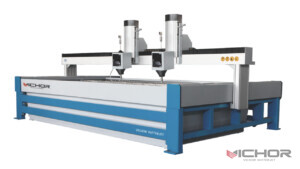
7 Facts About Water Jet Cutting Steel Thickness You Need to Know
When it comes to slicing through hard materials with precision and power, few technologies match the capability of water jet cutting steel thickness. Imagine a tool so versatile it can cut through a thin, delicate sheet of aluminum without warping it and then, with adjustments, slice through a thick block of hardened steel. This isn’t science fiction; it’s the everyday reality of abrasive waterjet cutting. If you’re involved in manufacturing, fabrication, or any field that requires precise metal cutting, understanding the relationship between water jet cutting steel thickness and the process’s capabilities is crucial. This article dives deep into seven key aspects that define how waterjets handle different steel thicknesses, empowering you to make informed decisions for your projects.
The Fundamental Science: How a Jet of Water Cuts Steel
At first glance, the idea that water can cut steel seems improbable. However, the process is a brilliant application of physics. Pure waterjet cutting, used for softer materials, relies on a ultra-high-pressure pump that intensifies water pressure to 60,000 PSI (and beyond). This pressurized water is then forced through a tiny orifice, often made of sapphire or diamond, creating a supersonic stream.
For cutting steel, an abrasive material, typically garnet, is introduced into this stream inside a mixing tube. The water stream accelerates the abrasive particles, transforming the jet into a potent erosive tool. It’s essentially a controlled, linear sandblasting process. The key to managing water jet cutting steel thickness lies in maintaining the coherence and energy of this abrasive-laden stream as it travels through the material. The interaction of these hard, fast-moving particles with the steel mechanically erodes it, resulting in a clean, precise cut without altering the material’s inherent structure.
The Practical Limits: How Thick Can a Waterjet Cut?
This is the most common question, and the answer isn’t a single number. The effective water jet cutting steel thickness is influenced by several factors, but general guidelines exist. Standard abrasive waterjet systems can consistently and accurately cut through mild steel up to 6 to 8 inches (150 to 200 mm) thick. For very thick materials, specialized systems with higher horsepower pumps can push this limit even further, sometimes up to 12 inches (300 mm) or more in certain applications.
However, it’s critical to distinguish between “cutting” and “piercing.” A waterjet can cut through great thicknesses by starting from an edge. Piercing a hole in the middle of a thick steel plate takes more time and can cause more top-side wear on the material. The “pierce delay” technique is used to avoid this. As the water jet cutting steel thickness increases, the cutting speed decreases significantly, and a phenomenon called “taper” becomes more pronounced, which we will address later.
The Critical Trade-Off: Speed vs. Thickness
In waterjet cutting, speed and thickness have an inverse relationship. This is one of the most important principles to grasp. When cutting thin sheets of steel (e.g., 1/8 inch or 3 mm), a waterjet can move very quickly, making it highly competitive with laser cutting for certain jobs. The process is fast, efficient, and produces a high-quality edge.
As the water jet cutting steel thickness increases, the cutting speed must drop. Cutting through 1-inch (25 mm) steel will be considerably slower than cutting 1/4-inch (6 mm) steel. For 6-inch thick steel, the speed is measured in inches per minute rather than feet per minute. This slowdown is necessary to allow the abrasive jet enough time to erode its way through the entire depth of the material. The pump pressure, abrasive flow rate, and nozzle focus must all be optimized for the specific thickness to ensure a clean cut from top to bottom without wasting energy or time.
Achieving a Quality Cut: Understanding Taper and Surface Finish
No cutting process is perfect, and with waterjets, the primary geometric challenge is “taper.” Taper occurs because the waterjet stream naturally loses energy and widens as it cuts deeper into the material. This results in a cut that is slightly wider at the top than at the bottom.
The degree of taper is directly related to the water jet cutting steel thickness. Thicker materials exhibit more noticeable taper. Fortunately, this can be managed. Modern CNC controllers use “taper compensation” algorithms. The software automatically tilts the cutting head by a minuscule, calculated angle as it moves, ensuring that the stream is perfectly vertical through the cut, resulting in edges that are square and parallel. The surface finish also changes with depth; the top of the cut is typically very smooth, while the bottom exit side may have a slight roughness or “strike line.” For critical applications, this can be managed with slower cutting speeds or secondary processing.

Why It’s a “Cold” Process: The Metallurgical Advantage
Unlike thermal cutting processes such as plasma or laser cutting, water jet cutting steel thickness is a cold-cutting method. The actual cutting is done by mechanical erosion, not by melting. The water stream itself acts as a coolant, dissipating any localized heat that is generated.
This offers a massive metallurgical advantage. Heat-Affected Zones (HAZ) are virtually eliminated. The inherent properties of the steel—its hardness, temper, and crystal structure—remain unchanged right up to the cut edge. This is indispensable for cutting tool steels, armor plate, and hardened metals where even a small HAZ can compromise the material’s integrity and lead to warping, micro-fractures, or weakened structural strength.
The Tools of the Trade: Pump Pressure and Nozzle Focus
The capability to handle varying water jet cutting steel thickness is rooted in the equipment. The heart of the system is the ultra-high-pressure pump. Two main types exist: intensifier pumps and direct-drive pumps. Intensifier pumps are renowned for generating consistently high pressures (up to 90,000 PSI or more), which is essential for cutting thicker, harder materials efficiently.
The cutting head, comprising the orifice and the mixing tube (nozzle), is equally critical. The orifice focuses the water into a coherent stream, and its size and quality determine the initial jet diameter. The mixing tube is where abrasive is entrained and focused. A worn mixing tube will produce a divergent, unfocused stream, leading to poor cut quality and an inability to handle maximum water jet cutting steel thickness. Regular maintenance of these consumable parts is non-negotiable for achieving consistent results.
Choosing Waterjet Over Other Methods for Steel
Why select a waterjet for your steel cutting project? It’s the combination of thickness range, material versatility, and cold-cutting nature. While lasers are faster for thin sheets, they struggle with highly reflective materials and thicknesses typically above 1 inch (25 mm). Plasma cutters are fast but produce a large HAZ and lower edge quality.
Water jet cutting steel thickness capability makes it a universal tool. A single machine can cut 1 mm thick rubber, 2-inch thick titanium, and 8-inch thick steel without changing the fundamental tool—only the parameters and the material stack. Its lack of HAZ, ability to start cuts without pre-drilled holes, and environmental friendliness (it produces no hazardous fumes) make it an incredibly flexible and valuable manufacturing solution.
Frequently Asked Questions (FAQs)
Q1: What is the maximum water jet cutting steel thickness for a standard machine?
A1: A standard industrial abrasive waterjet system can typically cut mild steel up to 6 to 8 inches (150-200 mm) thick. For materials beyond this range, specialized high-pressure pumps and advanced cutting heads are required, but it is technically possible to cut even thicker sections.
Q2: Does the cut quality change when increasing the water jet cutting steel thickness?
A2: Yes, it does. As the thickness increases, the cut edge may develop more noticeable taper and the bottom surface finish may become slightly rougher. However, using techniques like taper compensation in the CNC software and optimizing cutting speeds can effectively manage these issues to produce high-quality edges even on very thick sections.
Q3: Why is a waterjet better for cutting thick, hardened steel compared to a laser?
A3: Waterjet is a cold-cutting process, meaning it does not generate significant heat. Laser cutting melts the material, creating a Heat-Affected Zone (HAZ) that can anneal or weaken hardened steel, causing micro-cracks and loss of temper. Waterjet preserves the steel’s original metallurgical properties, making it the superior choice for hardened tools and high-strength alloys.
Q4: How does the cost of water jet cutting steel thickness change with thickness?
A4: The cost generally increases with thickness. Thicker materials require slower cutting speeds, consuming more time, water, electrical power, and abrasive garnet. The piercing time also increases. Therefore, the operational cost per inch of cut is higher for an 8-inch thick plate than for a 1-inch thick plate.
Q5: Can a waterjet make sharp corners when cutting thick steel?
A5: It can, but with a slight radius on the inside corner. Because the cutting stream is round, it cannot make a perfectly sharp internal corner. The radius will be approximately equal to the radius of the stream (kerf width). On thicker materials, this effect is more pronounced. For designs requiring perfectly sharp internal corners, a small “drill-out” or secondary process may be necessary.
continue reading


